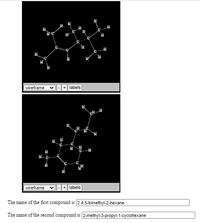
Chemistry
10th Edition
ISBN: 9781305957404
Author: Steven S. Zumdahl, Susan A. Zumdahl, Donald J. DeCoste
Publisher: Cengage Learning
expand_more
expand_more
format_list_bulleted
Concept explainers
Question
Name the

Transcribed Image Text:### Understanding Organic Compounds through Structural Diagrams
Below are two wireframe structural diagrams of organic compounds, accompanied by their IUPAC names for educational purposes. These structures help in visualizing the molecular conformation of organic chemistry compounds.
#### First Compound
**Graphical Representation**:
- The first diagram represents a wireframe model, where the atoms are depicted by labels 'C' for carbon and 'H' for hydrogen.
- The connections between the atoms (bonds) are represented by lines: single lines for single bonds.
- This model helps to understand the 3D spatial arrangement of the atoms in the molecule.
**IUPAC Name**:
The name of the first compound is **2,4,5-trimethyl-2-hexane**.
#### Second Compound
**Graphical Representation**:
- Similar to the first diagram, this is also a wireframe model with the same labeling and bonding representations.
- The structure of this compound depicts a cyclic arrangement indicating it's a cyclohexane derivative.
**IUPAC Name**:
The name of the second compound is **2-methyl-3-propyl-1-cyclohexane**.
### Key Points:
1. **Wireframe Model**:
- A wireframe model is a simplistic representation where atoms are shown by their respective symbols, and bonds are shown as lines.
- This model helps to easily visualize the molecular geometry and the connectivity between atoms.
2. **Organic Nomenclature**:
- The International Union of Pure and Applied Chemistry (IUPAC) nomenclature is a standardized method used to name organic chemical compounds.
- The systematic names such as 2,4,5-trimethyl-2-hexane and 2-methyl-3-propyl-1-cyclohexane provide detailed information about the structure of the compounds.
By examining these diagrams and names, students can strengthen their understanding of molecular structures and the principles of organic nomenclature.
Expert Solution
This question has been solved!
Explore an expertly crafted, step-by-step solution for a thorough understanding of key concepts.
Step by stepSolved in 2 steps with 2 images

Knowledge Booster
Learn more about
Need a deep-dive on the concept behind this application? Look no further. Learn more about this topic, chemistry and related others by exploring similar questions and additional content below.Similar questions
- Name the following alkenesarrow_forwardHow many alkene products are possible in the following reaction? CI CH3 NaOEt {"CH3 Harrow_forwardThe hydrogenation of 3-carene can yield two stereoisomeric alkane products. The reaction only yields one of the two products. Please draw the structures and circle the product formed and explain your choice.arrow_forward
- Question 12 of 30 Submit Provide the correct IUPAC name for the compound shown here. CH3 || H-C-CH2-CH-CH2-CH3 6- 1- 5-||4- 2- 3- tri iso cyclo di sec- tert- meth prop hex] pent but eth one oate an yl ol alarrow_forwardIs this alkene Z or Earrow_forwardPlease be clear in your writing The following names may have some errors. Correct the name and render the structures corresponding to the following names. g) 1,3-pentadiino h) cyclohexylacetylenearrow_forward
- Name the following alkenes. CI Br ill F LLarrow_forwardhow to name cyclic or acyclic alkanes ? what are the steps and rules that I have to follow to name anyone that comes my wayarrow_forwardConsider the substituted cycloalkene shown. Name substituents using branched alkyl group common names. Use hyphens (-), not en-dashes (–). The alkene is named:arrow_forward
arrow_back_ios
SEE MORE QUESTIONS
arrow_forward_ios
Recommended textbooks for you
 ChemistryChemistryISBN:9781305957404Author:Steven S. Zumdahl, Susan A. Zumdahl, Donald J. DeCostePublisher:Cengage Learning
ChemistryChemistryISBN:9781305957404Author:Steven S. Zumdahl, Susan A. Zumdahl, Donald J. DeCostePublisher:Cengage Learning ChemistryChemistryISBN:9781259911156Author:Raymond Chang Dr., Jason Overby ProfessorPublisher:McGraw-Hill Education
ChemistryChemistryISBN:9781259911156Author:Raymond Chang Dr., Jason Overby ProfessorPublisher:McGraw-Hill Education Principles of Instrumental AnalysisChemistryISBN:9781305577213Author:Douglas A. Skoog, F. James Holler, Stanley R. CrouchPublisher:Cengage Learning
Principles of Instrumental AnalysisChemistryISBN:9781305577213Author:Douglas A. Skoog, F. James Holler, Stanley R. CrouchPublisher:Cengage Learning Organic ChemistryChemistryISBN:9780078021558Author:Janice Gorzynski Smith Dr.Publisher:McGraw-Hill Education
Organic ChemistryChemistryISBN:9780078021558Author:Janice Gorzynski Smith Dr.Publisher:McGraw-Hill Education Chemistry: Principles and ReactionsChemistryISBN:9781305079373Author:William L. Masterton, Cecile N. HurleyPublisher:Cengage Learning
Chemistry: Principles and ReactionsChemistryISBN:9781305079373Author:William L. Masterton, Cecile N. HurleyPublisher:Cengage Learning Elementary Principles of Chemical Processes, Bind...ChemistryISBN:9781118431221Author:Richard M. Felder, Ronald W. Rousseau, Lisa G. BullardPublisher:WILEY
Elementary Principles of Chemical Processes, Bind...ChemistryISBN:9781118431221Author:Richard M. Felder, Ronald W. Rousseau, Lisa G. BullardPublisher:WILEY

Chemistry
Chemistry
ISBN:9781305957404
Author:Steven S. Zumdahl, Susan A. Zumdahl, Donald J. DeCoste
Publisher:Cengage Learning

Chemistry
Chemistry
ISBN:9781259911156
Author:Raymond Chang Dr., Jason Overby Professor
Publisher:McGraw-Hill Education

Principles of Instrumental Analysis
Chemistry
ISBN:9781305577213
Author:Douglas A. Skoog, F. James Holler, Stanley R. Crouch
Publisher:Cengage Learning

Organic Chemistry
Chemistry
ISBN:9780078021558
Author:Janice Gorzynski Smith Dr.
Publisher:McGraw-Hill Education

Chemistry: Principles and Reactions
Chemistry
ISBN:9781305079373
Author:William L. Masterton, Cecile N. Hurley
Publisher:Cengage Learning

Elementary Principles of Chemical Processes, Bind...
Chemistry
ISBN:9781118431221
Author:Richard M. Felder, Ronald W. Rousseau, Lisa G. Bullard
Publisher:WILEY